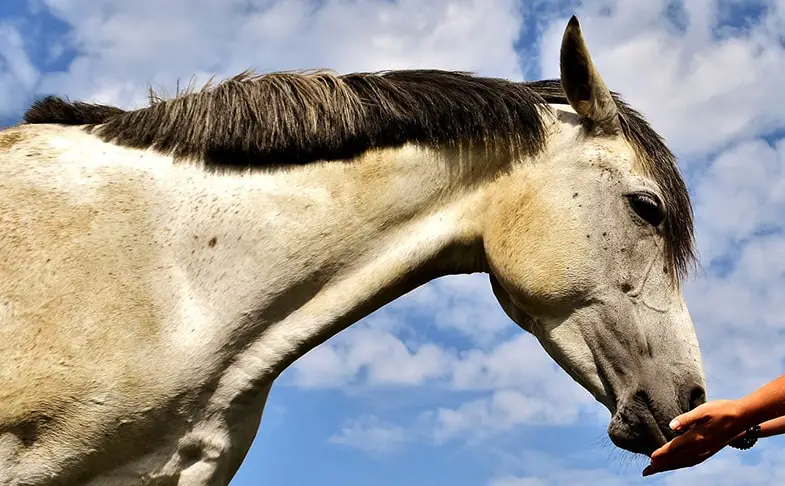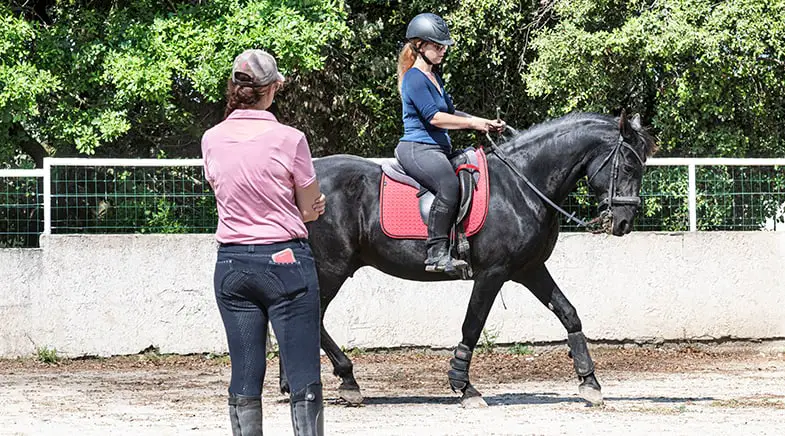Horseback riding is a wonderful thing that opens up a whole new world of possibilities but it can also be a dangerous hobby which is why it’s important to follow a few basic ground rules in order to make sure you and the people around you (as well as the horses of course) are safe.
While most riding stables will post their safety rules (sometimes referred to as house or barn rules) around the barn, it never hurts to know what they are beforehand. As Baden-Powell (the founder of the Boy Scouts of America) once said, you should always ‘be prepared’, and knowing how to be safe around horses is no exception.
1) Wear appropriate clothing
As a riding instructor who’s spent many decades teaching people to ride, I can honestly say I’ve seen everything when it comes to what clothing people think is okay to wear for horse riding. From swimming costumes to sneakers I’ve literally seen it all!
You might think that it doesn’t matter what clothing you wear when horseback riding but while you need to wear comfortable, sensible clothes what is more important is to make sure you have the correct safety gear. That includes footwear that won’t allow your feet to fall through the stirrups, a riding helmet that meets the current safety standards, and ideally a body protector too.
Not sure what clothing is suitable for horseback riding? A beginner’s guide to the correct riding attire.
2) Stay in front of the horse
When you consider that a horse can kick as fast as a NASCAR at top speed (that’s a whopping 200mph!), and almost twice as hard as a heavyweight boxer it’s easy to see why it’s not a good idea to walk behind them. Even if you’re familiar with a horse you should avoid their rear end and stand to their side if you need to brush their tail or pick their hooves.
Staying in front of the horse, or at least not going behind them, also includes when you approach. Being prey animals horses like to see when someone comes towards them and can easily panic if you creep from behind.
Not sure how to approach a horse? How to safely approach a horse.
3) Be calm and gentle around horses
Not only are horses prey animals but they’re also herd animals that feed off of each other’s emotions and how they behave. While this might not seem like it matters at first, after all, you’re not a horse, they will also look to you for signs of reassurance. This means that if you’re calm, gentle, and relaxed they will be too but if you’re in a bad mood, are agitated, or are anxious then they will be too.
As well as being calm you should also be consistent with the horse. As a general rule, horses want to make us happy and try to do what we’re asking of them but if you’re telling them to do something one minute and then, five minutes later asking them to do the opposite they’ll get confused, frustrated, and distressed.
Is your horse anxious? 12 ways to reduce a horse’s stress.
4) Make sure the horse knows you’re there
Don’t assume the horse knows that you’re there, even if you were stroking them a minute ago they may not realize you’re still there so it’s always a good idea to talk to the horse before you start stroking them or doing anything around them. This might sound like a strange thing to say and you may feel daft talking to a horse you’ve been standing close to for a while but the horse may well have been distracted and forgotten you were there.
This is even more true of horses that you know are nervous.
5) Respect the horse
It’s important that the horse knows you’re the boss and that they can’t just do what they want but there’s a fine line between respect and abuse. Be firm and assertive with the horse but don’t be aggressive towards them, no matter what they’re doing.
Think about how you’re acting towards the horse and how you’d feel if somebody was like that towards to.
Not sure how to discipline a horse? Why punishing horses never works, and how to correct their behavior.
6) Lead the horse safely
If you’re asked to lead the horse at all you should make sure you’ve got hold of the lead line properly and securely and that you’ve got control of the horse. Wrapping your hand around the rope might sound like a good idea but if the horse spooks at something you could easily be dragged along with them. Likewise, if you’re just loosely holding the end of it then the horse can easily pull the rope out of your hands.
How you actually lead the horse will to some extent be determined by how they’ve been trained. Typically Western horses are lead from in front with plenty of slack in the rope, while English horses are lead from the side in that you hold the lead line close to the halter. Listen to how your instructor tells you to lead them and do what they say.
7) Tie the horse securely
Being able to tie a horse up securely is without a doubt one of the most important things you can ever learn and could be called upon at any time. Even if the horse is already tied up for you when you arrive you should still learn how to do it yourself, you never know when you’ll need to.
It’s not as simple as tying a knot in the lead line and leaving the horse. If the horse panics or you need to undo the knot quickly then a square knot won’t be easy to undo, especially if the horse has been pulling on the rope and tightening the knot. Instead, you’ll need to use a quick-release knot which is exactly what it sounds like, it’ll give you the ability to undo the knot super quickly.
Want to learn how to tie a quick-release knot? 5 knots every horseback rider should know.
8) Listen to your instructor
Okay so I admit this rule is more common sense than anything else but I feel that it should also be on this list, after all, your instructor knows the horses and knows how best to act around them. Listening to what they say will help you to be safe while you’re there.
Takeaway message
Following these rules will help you to stay when you’re around horses and while you’re riding. Having a basic understanding of how horses behave and being cautious and respectful towards them can help to reduce the risk of accidents.
Stay safe and happy riding!
I hope you found this article helpful. If you did I’d be grateful if you could share it please as it would really help me.
Recommended products
Over the years I have tried hundreds of different horsey products, from various blankets and halters to different treats. Some I’ve loved, others I’ve hated but I thought I’d share with you my top all-time favorite products, the ones I never leave the yard without. I’ve included links to the products (which are in no particular order) that I really think are great.
- Horse Knots by Reference Ready – If you’re like me and enjoy pocket reference guides then you’ll love this knot tying guide. These handy cards can easily fit in your pocket or attach to the saddle for quick reference. They’re waterproof, durable and are color coded to make them easy to follow.
- Mane ’n Tail Detangler – Even if you never show your horse you’ll need to detangle his tail from time to time (and possibly his mane too) which is always a challenging chore! I’ve found that if I run a little bit of detangler through my horse’s tails every few days it stops them from getting matted up and makes combing them easy, even if they’re coated in mud. I don’t know if I should admit to this or not but it also works wonders on my hair.
- TAKEKIT Pro clippers – Over the years I’ve tried a lot of different clippers and while some were obviously better than others I found these to be by far the best. They are heavier than a lot of other clippers but for me, that’s a good thing, it makes them feel more sturdy and hardwearing. On top of that they have a range of speeds so are just as good for clipping your horse’s back as they are his face. I also like the fact that they come in a handy carry case but that’s not for everybody. The company that makes them is super good and incredibly helpful too, a real bonus these days. The only thing I wasn’t keen on was the fact that it doesn’t come with any oil, but that’s not a major problem as it’s not difficult to buy lubricant.
- Shire’s ball feeder – There are so many boredom buster toys out there but I like to use these every day, regardless of whether or not my horses are bored. I find that it helps to encourage my horses to problem solve by rewarding them with treats (or pieces of fruit) but it also mimics their natural grazing behavior which helps to keep them calm and de-stressed.
- Horse safe mirror – This is a strange one that many people are surprised about but I like to put horse safe mirrors in the trailers as well as in the quarantine stalls. It helps to prevent the feeling of isolation by giving the impression of other horses being around. Being herd animals horses can get extremely stressed when they feel that they’re on their own but with these stick-on mirrors, they believe that at least one other horse is with them.
- Rectal thermometer – I know this isn’t glamourous at all but it’s vital for your horse’s well-being to be able to check their temperature and a rectal thermometer is the easiest way of doing this which is why I’ve added it to the list.
Shopping lists
I’ve also put together a few shopping lists of essential items that I’ve found helpful over the years. I’ve broken the lists down into different categories rather than put everything in one massive list 😉



